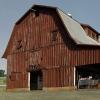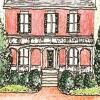Athens Rising
What's Up in New Development

Luckily, Walker's Coffee and Pub succeeded where Blue Sky Coffee failed.
Beer goggles—they happen to the best of us.
Two weeks ago, I attended the Athens Clarke Heritage Foundation’s Third Annual Historic Pub Crawl on the corner of Historic Avenue and Cold Beer Street. A great time was had by all as we crawled through five historic watering holes while enjoying tasty Terrapin brews. I was impressed not only by the history of each building we visited, but by the way they've been preserved.
I do, however, wonder if my impressions were a bit tainted by the beer goggles. Perhaps you could take a self-guided tour yourself and see if you agree.

The Branded Butcher and its trademark Art Moderne windows.
Our first stop was The Branded Butcher. Built in the 1930s, this simplified, geometric Art Moderne building complements the adjacent Georgia Theatre’s Art Deco motifs. Like many Art Moderne buildings, The Branded Butcher has large, single-paned windows, which were popular then due to advancements in glass-making. The original occupant was the Palmisano Radio Co. in the 1930s. The site has also been the home of several bakeries, a beauty shop, a dressmaker, a radio station, several professional offices and a tapas bar. Though the interior of the building has changed over time, the envelope and façade remain intact, which brings us to our next stop, The Volstead.
Built in 1893 and restored to its original appearance in 2011, The Volstead won the Athens Clarke Heritage Foundation’s 2012 Outstanding Rehabilitation Award. The owners, Brian and Chris Holloway, were able to restore the triple-stone arcade façade after finding a photograph in a newspaper advertisement for T. Flemming and Sons hardware and vehicles, the former tenants of the building.

The Volstead.
The Holloways wanted to be as true to the historic fabric as they could. In addition to restoring the façade, they also exposed the original pressed tin ceiling inside and on the patio, and restored the iron Corinthian columns that run through the center of the building. Though the original heart pine flooring and pressed tin ceiling had to be removed to create the kitchen, the flooring was repurposed as the bar top, and the original ceiling panels are now the bar front. I was very pleased to see this historic building restored to its former glory.
We then crawled across the street to the Mad Hatter, which made me very excited because I’ve always thought this was one of the greatest spaces in town. Built in 1910, the Max Joseph Building housed the James Music Co. and a Masonic lodge. By the 1920s, it was known as the Moss Auditorium. (The façade is small, but the windowless side stretches halfway down Wall Street. Perhaps that's why it was named “Wall” Street?)

The Mad Hatter used to be a department store but sat vacant for decades.
In the 1930s, when department stores began opening downtown, this space housed the Gallant-Belk Co., which it remained until the 1960s. (J.C. Penney opened next door in the 40s, and Macy’s opened in the Michael Brothers Building in the 50s.) This whole section of Clayton Street declined in the '70s and '80s as sprawl and shopping malls pushed commerce away from downtown and towards the suburbs. The building sat vacant for years before being turned into lofts and bars in the 1990s.
After a Terrapin Rye, Hopsecutioner and Hop Karma, we then visited Walker’s Coffee and Pub for the high-gravity Monk’s Revenge, where I channeled many great writers and Athenians of the past. (Thankfully, I was pretty familiar with the last two stops.) Built in 1900, the building originally had two storefronts, office space upstairs and a basement to house the Columbia Tailoring Co., followed by the Hinton Securities and Transfer Co., the Georgia Railroad terminal manager and, later on, several professional offices from the 1930s through 1960s.
By the 1970s the whole of downtown began to shift to cater to college students, and this building became home to the clothing store Glass of Hillwall (known for hippie attire) and in 1986 became Ruthless Records. Many of us are familiar with Blue Sky Coffee (sniffle… tear), which occupied this space from 1995 to 2004. Its failed expansion took out the center wall. Walker’s somehow managed to do exactly what Blue Sky had set out to do when they expanded (coffee, booze and late-night hours), but much more successfully. Rage Hair Studio has occupied the second-floor space for more than 10 years.
Our last stop was The Grotto, formerly Rye Bar, DT’s Down Under and The Downstairs, where we enjoyed a delicious Moo Hoo. This vernacular Beaux Arts building was constructed in 1910 to house the Taylors Electric Co., but since the 1930s the building has repeatedly been used as various retail stores and apartments. There are a few businesses around town that have utilized the basement space of buildings. I think the inner child in many people is what makes a basement successful. (Personally, I’d love to see an attic!) The former storage space, astrologer’s office, grungy bar is now an intimate cocktail lounge.
Joining the ACHF on their pub crawl was a great and enjoyable way to see how historic spaces downtown are being utilized today and learn about the history and preservation of them. Downtown is full of history; I wonder what the future will bring.
More by Stella Smith
-

Is the Chain Gang Taking Over Downtown Athens?
Local businesses are closing or moving and chains are taking their place.
-

-

A Historic Garden Is Coming to the Ware-Lyndon House
No one knows what it might have looked like, but they're giving it their best shot.









comments